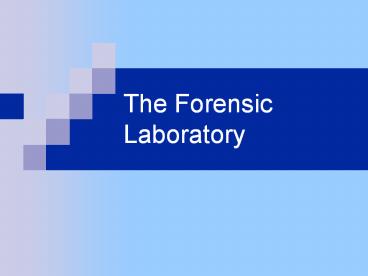The Forensic Laboratory - PowerPoint PPT Presentation
1 / 22
Title:
The Forensic Laboratory
Description:
The Forensic Laboratory K-Fed sez: Quiz on Friday. Summary Lab management Accreditation and certification Qualification of forensic examiner Role of criminalist ... – PowerPoint PPT presentation
Number of Views:492
Avg rating:3.0/5.0
Title: The Forensic Laboratory
1
The Forensic Laboratory
2
- K-Fed sez
- Quiz on Friday.
3
Summary
- Lab management
- Accreditation and certification
- Qualification of forensic examiner
- Role of criminalist
- Introduction to evidence
- Introduction to lab sections
4
Lab Management
- Forensic laboratory not only analyzes physical
evidence, but is also involved in its
recognition, collection, and preservation.
- Members of the crime lab are also involved in
educating and training officers on these subjects
- Members of the crime lab are also involved with
educating attorneys, judges, and juries on how to
weigh the results of analysis.
5
Lab Management gt Quality Assurance
- Quality Assurance (QA)
- Programs that are designed to ensure that a labs
results are scientifically valid and reported
opinions are reliable
May include
- Required education
- Peer review of reports
- Documentation rules
- Auditing testimony
- Evidence handling rules
- Lab security
6
Lab Management gt Quality Assurance
- Quality Assurance (QA)
- Programs that are designed to ensure that a labs
results are scientifically valid and reported
opinions are reliable
An important part of quality assurance programs
is proficiency testing.
7
Lab Management gt Quality Assurance gt Proficiency
Testing
- Proficiency Tests
Simulated forensic cases with known results
Can be done
- Internally (by the lab being tested) or
- Externally (by an outside testing agency)
External agencies will compile and publish their
results to benefit all labs.
8
Lab Management gt Quality Assurance gt Staffing
- Staffing
National guidelines provide education
requirements
- Degree requirements
- Specific coursework requirements
Many labs include an extensive background
investigation.
9
Lab Management gt Section Organization
- Section Organization
- Analysts (entry level)
- Perform the analysis (specialized in one area)
- Currently hire scientists
- Older employees may be trained officers
- Section Supervisors
- Supervise one area of the lab (Drugs, DNA, Trace)
- May also examine cases
- Supervisory duties can be distributed among
persons who report to the head supervisor - Are scientists (or older trained officers)
10
Lab Management gt Quality Assurance
Section Organization
- Quality Assurance Manager
- Make sure QA requirements are met
- Lab Director
- Must have a range of forensic knowledge
- Does not analyze evidence
- Anticipates staffing, equipment, and training
needs - Also helps to make sure QA requirements are met
11
Accreditation and Certification
- Accreditation
- Laboratories should be accredited
- Labs are accredited by ASCLD
- American Society of Crime Lab Directors
12
Accreditation/Certification gt Accreditation
- Accreditation
- Begins with application and inspection
- Review of written procedures
- Review of Quality Assurance programs
- Review security and safety
- After inspection, the lab corrects any problems
found
- Accreditation lasts 5 years
- Must submit annual self-evaluation, including
proficiency tests - After 5 years, lab is reinspected
13
Accreditation/Certification gt Certification
- Certification
Criminalists (people) can be certified.
Criminalists are certified by ABC (American Board
of Criminalistics), IAI (International
Association of Identification), and other
organizations.
14
Accreditation/Certification gt Accreditation
Certification
Must apply and submit to written tests
- Renewed annually by providing an account of
professional activities. - Training/Education
- Publications
- Proficiency test results
15
Types of Labs
Accreditation/Certification gt Types of Labs
- Government Labs (see previous lecture)
- Private Labs
- One important purpose of private labs is they
provide a defendant with the ability to refute
scientific evidence presented by the prosecution.
16
Qualifications of a Criminalist
- B.S. in natural sciences
- Even with a MSFS degree, most training will be
on-the-job. - Accredited labs have written training manuals
detailing the training process.
17
Qualifications of a Criminalist
- Higher education (MSFS or Ph.D.) is required for
certain supervisory positions
- Accreditation and Certification require employees
to continue their education - Forensic meetings
- Training courses
- In-house training
18
Role of Criminalist gt Investigator/Educator/Studen
t
- A criminalist must perform the duties of an
investigator, educator, and student.
- Investigator
- Must obtain information from police investigators
that could affect scientific analysis (condition
of evidence, information needed from evidence). - Must be careful to not become too emotionally
involved.
19
Role of Criminalist gt Investigator/Educator/Studen
t
- A criminalist must perform the duties of an
investigator, educator, and student.
- Educator
- Educating related professionals as to the
criminalists capabilities.
- Judges
- Medical Professionals
- Officers/CSI
- Attorneys
- Publish research or case studies for other
forensic scientists to read.
20
Role of Criminalist gt Investigator/Educator/Studen
t
- A criminalist must perform the duties of an
investigator, educator, and student.
- Student
- New techniques require continuing education
- Read Journals
- Scientific Meetings
- Conduct Research
- Attend Workshops
- Some work requires in depth research on a
particular topics (example in text ropes)
21
Introduction to Evidence
- Reconstruction Evidence
- Associative Evidence
- Class Characteristics
- Identification
22
Introduction to Lab Sections
- Biological Evidence
- Trace Evidence
- Fingerprint Evidence
- Impression Evidence
- Firearm and Tool Mark Evidence
- Questioned Documents
- Chemical Evidence (drugs, arson, BAC)































